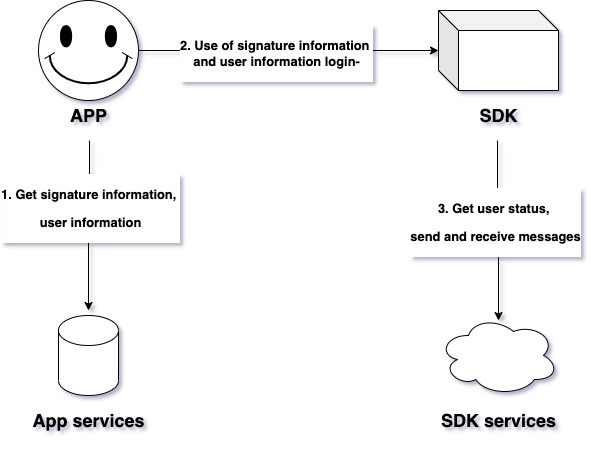How to Implement Super Live Chat: 3 Methods You Should Know
How to implement your own super live chat? Whether to choose to use open source code, develop in-house, or choose to use a commercial SDK
Introduction
Super live chat is a service that allows users to communicate with each other in real-time over the Internet.
Super live chat is an important function of popular apps on the market, such as WhatsApp and Facebook Messenger. Developing a super live chat architecture is much harder than it looks — numerous technologies have to be employed to meet high real-time demands, including massive concurrent requests, super-low latency, and 100% delivery of messages.
In recent years, driven by the rapid development of mobile technology and the growing trend for social features in the app market, Super live chat is widely used for communication on social media platforms, and in scenarios as diverse as e-commerce, live streaming, and customer service, etc.
Research shows that more than 60% of apps on the market have the super live chat feature, through which users can chat with each other in real-time, thus improving app engagement and user experience. For app developers, Super live chat implementation has become a must-have skill.
With more than 10 years of experience in developing super live chat apps, the author shares three options for super live chat implementation and hopes this article could be of help to super live chat developers.
How to implement Super live chat
Developers may build a super live chat app via 1) open-source code 2) in-house development 3) commercial SDK integration based on the project needs.
Client-side development, server-side development, and O&M are the three key parts for turning an idea into an IM product and keeping it up and running.
Client-side development involves mobile apps, desktop software, webpages, and mini-programs. Server-side development is about the implementation of all super live chat functions, such as user access, relationship maintenance, sending/receiving messages, file and photo storage, and security audit.
Continuous O&M is required to ensure a stable and reliable environment on the server side for the IM app, such as scaling up the server in case of a surge in workload.
It's not easy to realize any of the above from scratch. In particular, in-house development requires a highly capable project team and abundant resources. Generally, large companies would develop software entirely on their own while others use open source codes or integrate a commercial SDK. Differences between the three methods are summarized as follows:
Table: 3 methods of super live chat implementation
| Open source code | In-house development | Commercial SDK | |
| Difficulty | Low | High | Medium |
| Functional scalability | Difficult; dependent on the open source project plan | Easy; independent of external conditions | Medium; dependent on SDK providers |
| O&M cost | High; in-house O&M | High; in-house O&M | In-house O&M not required |
| Product launch cycle | Medium | Long | Short |
| Target audience | Individuals learning app development | Large companies with strong R&D capabilities | Small and medium-sized enterprises and personal studios |
Method 1: Use open-source projects
Using an open-source project is the fastest way to implement super live chat as you can embark on a fast-track product development by drawing on the wisdom of the whole community.
What should we focus on when choosing an open-source project for super live chat? The maturity of functions and the number of active users are two important aspects to consider when choosing an open-source project. Based on my experience, I would like to share with you two good open-source projects.
MongooseIM
Project URL: github.com/esl/MongooseIM
MongooseIM is Erlang Solutions' robust, scalable and efficient XMPP server, aimed at large installations. Specifically designed for enterprise purposes, it is fault-tolerant and can utilize the resources of multiple clustered machines.
OpenIM
Project URL: github.com/OpenIMSDK/Open-IM-Server
OpenIM was founded and developed by senior IM architects and IM/WebRTC experts, aiming at creating service value and developing lightweight, high-availability super live chat architecture through open source technology. With OpenIM, developers can easily build multiple IM and real-time interactive audio/video scenarios in an app.
An open-source project is a great option for developers who have to meet a tight deadline and without too many needs for customization to realize fast IM implementation. However, the project provides only simple and basic functions, and adding new functions relies heavily on its development progress. If you want to create a bespoke IM app, or if you expect a growing business, I advise you against using this method.
Teams with R&D capabilities usually prefer in-house development if they want a custom IM product. The next part will guide you through the technical difficulties and pitfalls in the process of in-house development.
Method 2: In-house development
Developing a super live chat product entirely by in-house teams requires a high cost and extensive, essential software development expertise within an organization. In addition, the development cycle may be lengthy. You need to make long-term planning to avoid missing business opportunities.
When developing a super live chat app in-house, we have met some technical difficulties in the following areas:
- Reliability and order of messages.
- Real-time messaging and pulling of messages in case of massive concurrent requests.
- Message storage options: "pull" or "push" model.
- Accurate calculation of unread messages.
- Group chat acknowledgment messages.
- Multi-data center deployment.
You may bundle some features of full-fledged products on the market into your app, such as file storage, security audit, and offline push notification, to accelerate the development. If you decide to develop such features by yourself in the future, you can easily replace them to maximize efficiency.
Deep-pocketed and technical-savvy enterprises that expect an enormous user base are advised to choose in-house development to fulfill their needs for functional scalability, fast iteration, and stable O&M.
Given the considerable financial and human resources required during this process, I recommend that in-house developers make a sound development plan to avoid unnecessary loss.
Here is a summary of the downsides of the two super live chat implementation methods we have discussed: If you choose an open-source project, it would be a bit difficult to add new functions and the O&M is complex, making it hard to support the product's long-term development. In-house development takes time and costs a lot of money.
Is there a compromise solution that needs a short development timeline, requires less investment, and supports customization? Yes. Integrating a commercial SDK is the easiest and a popular way to develop software applications. Many companies would choose SDKs from full-blown providers.
Method 3: Integrate a commercial SDK
This method is appealing because it:
- enables quick implementation of an IM product to gain competitive edges.
- offers stability to reduce O&M work.
- supports functional scalability: If a new function is required, just get your request to the SDK provider.
- requires much less cost than in-house development.
Process of super live chat implementation When you choose to integrate a commercial SDK, follow the process below to implement super live chat:
- Apply for a user account and get the password from the SDK provider.
- Develop a service backend used to calculate the authentication information.
- Integrate the SDK and develop your app.
Let's take sending/receiving messages as an example. Modules interact with each other, as shown below:

To sum up, if you choose this method, all you need to do is develop a simple service backend, integrate the SDK, and develop your app. With all being done, you can launch your app quickly.
Recommended SDK providers
There are many mature IM SDK providers on the market. I would like to recommend some of them.
ZEGOCLOUD
ZEGOCLOUD, a global cloud communication service provider that founded in June 2015.
It provides high-quality audio/video communication and IM services for more than 4,000 clients around the world.
ZEGOCLOUD's IM SDK is specially developed for audio/video communications. It can be used with voice and video SDKs to enable, for example, real-time engagement during live-streamed content. If your app's audio/video and the IM capabilities are built on products from different suppliers, users may experience a huge stream delay. ZEGOCLOUD's IM SDK can address this problem.
You can choose ZEGOCLOUD if you need to build IM into your audio/video-related platforms, such as live streaming, conference, education, and games.
Sign up with ZEGOCLOUD, get 10,000 minutes free every month.
CometChat
Founded in 2009, CometChat is committed to IM technology development and supports many platforms and frameworks, such as iOS, Android, React, Angular, and Vue.
It also provides developers with various solutions, such as Chat Widgets, Chat UI Kits, and Chat SDKs.
If you are developing a dating app with IM as the core feature, CometChat would be a good choice for you.
Did you know? 👏
**Like**, **Follow**, **share** is the biggest encouragement to me
**Follow me** to learn more technical knowledge
Thank you for reading :)
Learn more
This is one of the live technical articles. Welcome to other articles:
